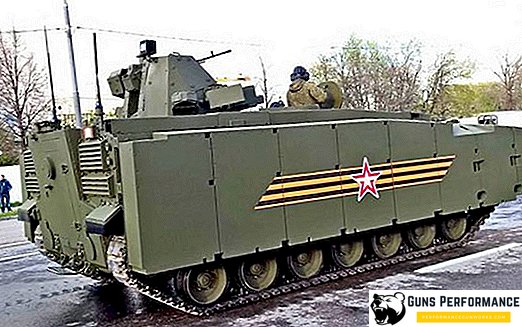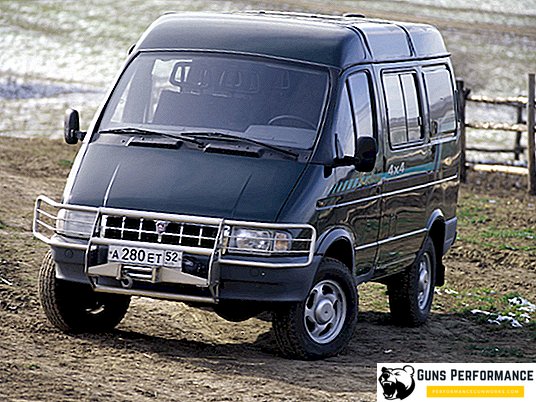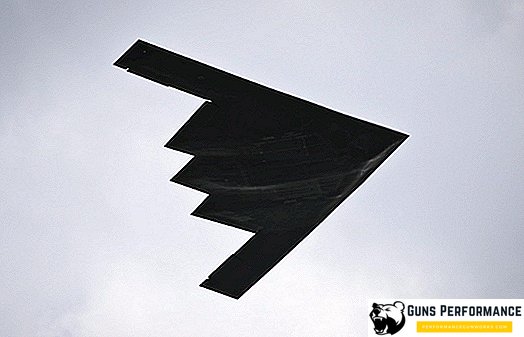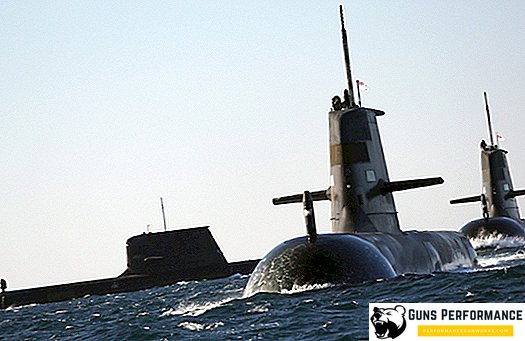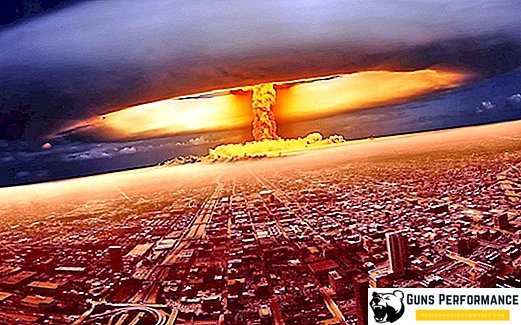
July 16, 1945 at the US Air Force Base in New Mexico, an event occurred that changed the entire subsequent history of mankind. At 5 hours 30 minutes local time, the world's first nuclear bomb Gadget, with a capacity of 20 kilotons in TNT, was exploded here. According to eyewitnesses, the brightness of the explosion significantly exceeded sunlight at noon, and a cloud of mushroom shape reached an altitude of 11 kilometers in just five minutes. These successful trials were the beginning of a new era of humanity - nuclear. In just a few months, the people of Hiroshima and Nagasaki will fully experience the power and rage of the created weapon.
The Americans did not have a monopoly on a nuclear bomb for a long time, and the next four decades became a period of tough confrontation between the US and the USSR, which was included in history books called the Cold War. Nuclear weapons today are the most important strategic factor that everyone has to reckon with. Today, the elite nuclear club actually includes eight states, several more countries are seriously engaged in the creation of nuclear weapons. Most of the charges are in the arsenal of the United States and Russia.
What is a nuclear explosion? What are they like and what is the physics of a nuclear explosion? Is modern nuclear weapons different from the charges that were dropped on Japanese cities seventy years ago? Well and the main thing: what are the main striking factors of a nuclear explosion and is it possible to defend against their impact? All this will be discussed in this material.
From the history of this issue
The end of the 19th and the first quarter of the 20th century became for nuclear physics a period of unprecedented breakthroughs and amazing accomplishments. By the mid-1930s, scientists had made almost all the theoretical discoveries that made it possible to create a nuclear charge. In the early 1930s, the atomic nucleus was first split, and in 1934, the Hungarian physicist Silard patented the design of a nuclear reactor.
In 1938, three German scientists - Fritz Strassmann, Otto Hahn and Lisa Meitner - discovered the process of fission of uranium during neutron bombardment. This was the last stop on the way to Hiroshima, soon the French physicist Frederic Joliot-Curie received a patent for the design of a uranium bomb. In 1941, Fermi completed the nuclear chain reaction theory.

At this time, the world inexorably rolled into a new global war, so the research of scientists aimed at creating weapons of unprecedented crushing force could not go unnoticed. Great interest in such studies showed the leadership of Hitler's Germany. Possessing an excellent scientific school, this country could well be the first to create nuclear weapons. This prospect greatly disturbed the leading scientists, most of whom were extremely anti-German. In August 1939, at the request of his friend Sylard, Albert Einstein wrote a letter to the President of the United States, indicating the danger of a nuclear bomb in Hitler. The result of this correspondence was first the Uranium Committee, and then the Manhattan Project, which led to the creation of American nuclear weapons. In 1945, the United States already had three bombs: the plutonium "little thing" (Gadget) and the "fat man" (Fat boy), and also the uranium "Little boy" (Little boy). The "parents" of the American NW are the scientists Fermi and Oppenheimer.
July 16, 1945 at the site in New Mexico, undermined the "Thing", and in August, "Kid" and "Fat Man" dropped on Japanese cities. The results of the bombing exceeded all expectations of the military.
In 1949, nuclear weapons appeared in the Soviet Union. In 1952, the Americans first tested the first device, which was based on nuclear fusion, not decay. Soon the thermonuclear bomb was created in the USSR.
In 1954, the Americans blew up a 15 megaton trinitrotoluene device. But the most powerful nuclear explosion in history took place a few years later - a 50-megaton Tsar-Bomba was blown up on Novaya Zemlya.
Fortunately, both in the USSR and in the USA they quickly understood what a large-scale nuclear war could lead to. Therefore, in 1967, the superpowers signed the NPT Non-Proliferation Treaty. Later, a number of agreements relating to this area were developed: SALT-I and SALT-II, START-I and START-II, etc.
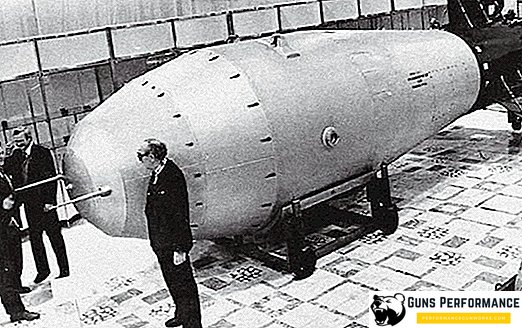
Nuclear explosions in the USSR were carried out on Novaya Zemlya and in Kazakhstan, the Americans tested their nuclear weapons at a test site in the state of Nevada. In 1996, we accepted an agreement to ban any testing of nuclear weapons.
How is the atomic bomb?
A nuclear explosion is a chaotic process of releasing an enormous amount of energy that is formed as a result of a nuclear fission or synthesis reaction. Similar and comparable power processes occur in the depths of stars.
The nucleus of an atom of any substance is divided when neutrons are absorbed, but for most elements of the periodic table, this requires spending considerable energy. However, there are elements capable of such a reaction under the influence of neutrons, which have any - even minimal - energy. They are called fissile.
Uranium-235 or plutonium-239 isotopes are used to create nuclear weapons. The first element is found in the earth's crust, it can be isolated from natural uranium (enrichment), and weapon-grade plutonium is obtained artificially in nuclear reactors. There are other fissile elements that can theoretically be used in nuclear weapons, but their receipt is associated with great difficulties and costs, so they are almost never used.
The main feature of a nuclear reaction is its chain, that is, self-sustaining nature. When an atom is irradiated with neutrons, it breaks up into two fragments with the release of a large amount of energy, as well as two secondary neutrons, which, in turn, can cause the fission of neighboring nuclei. So the process becomes cascading. As a result of a nuclear chain reaction in a short period of time, an enormous amount of “fragments” of decaying nuclei and atoms in the form of a high-temperature plasma: neutrons, electrons and quanta of electromagnetic radiation is formed in a very limited volume. This clot is rapidly expanding, forming a shock wave of tremendous destructive power.
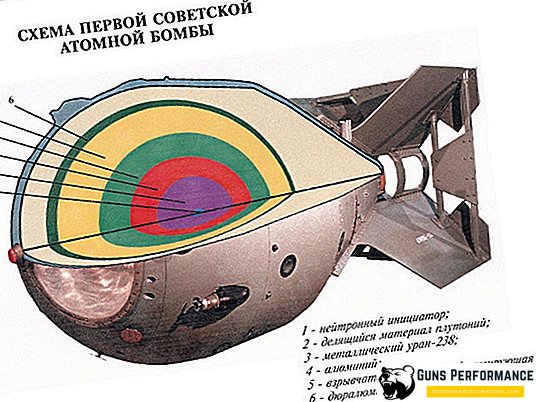
The overwhelming majority of modern nuclear weapons do not work on the basis of a chain decay reaction, but due to the fusion of the nuclei of light elements, which start at high temperatures and high pressure. In this case, an even greater amount of energy is released than during the decay of nuclei such as uranium or plutonium, but in principle the result does not change - a region of high-temperature plasma is formed. Such transformations are called thermonuclear fusion reactions, and the charges in which they are used are thermonuclear.
Separately, it should be said about special types of nuclear weapons, in which most of the energy of fission (or synthesis) is directed to one of the factors of damage. These include neutron munitions that generate a stream of hard radiation, as well as the so-called cobalt bomb, which gives the maximum radiation contamination of the area.
What are the nuclear explosions?
There are two main classifications of nuclear explosions:
- on power;
- by location (point of charge) at the time of the explosion.
Power is the defining characteristic of a nuclear explosion. It depends on the radius of the zone of complete destruction, as well as the size of the territory contaminated by radiation.
To estimate this parameter, the TNT equivalent is used. It shows how much trinitrotoluene needs to be blown up in order to get comparable energy. According to this classification, there are the following types of nuclear explosions:
- ultra small;
- small;
- medium;
- large;
- extra large.
At the ultralow (up to 1 kT) explosion, a fireball is formed with a diameter of not more than 200 meters and a mushroom cloud with an altitude of 3.5 km. Super-large ones have a power of more than 1 mT, their fireball exceeds 2 km, and the height of the cloud is 8.5 km.
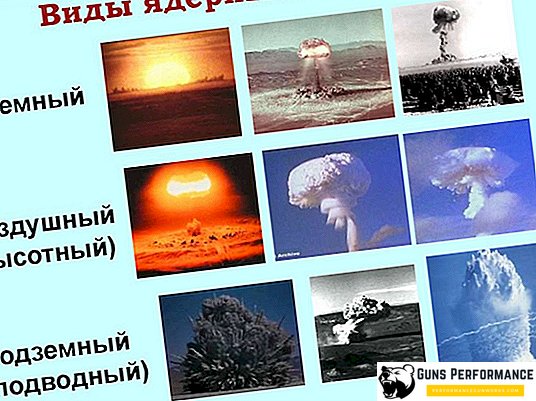
An equally important feature is the location of the nuclear charge before the explosion, as well as the environment in which it occurs. On this basis, the following types of nuclear explosions are distinguished:
- Atmospheric. Its center can be at a height of several meters to tens, or even hundreds of kilometers above the ground. In the latter case, it belongs to the category of high-altitude (from 15 to 100 km). An aerial nuclear explosion has a spherical flash shape;
- Space. To fall into this category, it must have a height greater than 100 km;
- Ground. This group includes not only explosions on the surface of the earth, but also at a height of several meters above it. They pass with the release of the soil, and without it;
- Underground. After the signing of the Treaty on the Prohibition of Testing Nuclear Weapons in the Atmosphere, on Earth, Under Water, and in Space (1963), this type was the only possible way to test nuclear weapons. It is carried out at different depths, from several tens to hundreds of meters. Under the thickness of the earth, a cavity or a collapse column is formed, the force of the shock wave is significantly weakened (depending on the depth);
- Surface. Depending on the height, it can be contactless and contact. In the latter case, the formation of an underwater shock wave;
- Underwater. Its depth is different, from tens to many hundreds of meters. On this basis, it has its own characteristics: the presence or absence of the "Sultan", the nature of radioactive contamination, etc.
What happens in a nuclear explosion?
After the start of the reaction, a significant amount of heat and radiant energy is emitted within a short period of time and in a very limited volume. As a result, temperature and pressure increase in the center of a nuclear explosion to enormous values. From afar, this phase is perceived as a very bright luminous dot. At this stage, most of the energy is converted into electromagnetic radiation, mainly in the X-ray part of the spectrum. It is called the primary.
Ambient air is heated and expelled from the point of explosion at supersonic speeds. A cloud is formed and a shock wave is formed, which is detached from it. This occurs approximately 0.1 msec after the start of the reaction. As it cools, the cloud grows and begins to rise, dragging along the infected soil particles and air. At the epicenter of the formation of a funnel from a nuclear explosion.
Nuclear reactions occurring at this time become the source of a number of different radiations, from gamma rays and neutrons to high-energy electrons and atomic nuclei. This is how penetrating radiation of a nuclear explosion arises - one of the main damaging factors of nuclear weapons. In addition, this radiation affects the atoms of the surrounding substance, turning them into radioactive isotopes that infect the area.
Gamma radiation ionizes the atoms of the environment, creating an electromagnetic pulse (EMP), which disables any electronic devices nearby. The electromagnetic pulse of high-altitude atmospheric explosions spreads to a much larger area than with ground or low-altitude.
What is dangerous atomic weapons and how to protect against it?
The main striking factors of a nuclear explosion:
- light emission;
- shock wave;
- penetrating radiation;
- contamination of the area;
- electromagnetic pulse.
If we talk about a ground explosion, half of its energy (50%) goes to the formation of a shock wave and a funnel, about 30% comes from the radiation of a nuclear explosion, 5% from an electromagnetic pulse and penetrating radiation, and 15% from contamination of the terrain.
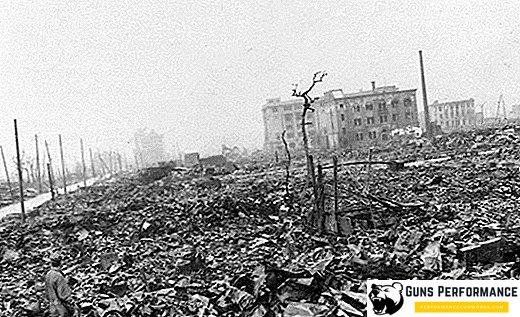
The light radiation of a nuclear explosion is one of the main damaging factors of nuclear weapons. It is a powerful flux of radiant energy, which includes radiation from the ultraviolet, infrared and visible parts of the spectrum. Its source is a cloud of explosion in the early stages of existence (fireball). At this time, it has a temperature of from 6 to 8 thousand ° C.
Light radiation propagates almost instantly, the duration of this factor is calculated in seconds (up to a maximum of 20 seconds). But, despite the short duration, light radiation is very dangerous. At a short distance from the epicenter, it burns all combustible materials, and at a distance leads to large-scale fires and fires. Even at a considerable distance from the explosion may damage the organs of vision and skin burns.
Since the radiation propagates in a straight line, any non-transparent barrier can become a defense against it. This damaging factor is significantly weakened in the presence of smoke, fog or dust.
The shock wave of a nuclear explosion is the most dangerous factor of nuclear weapons. Most damage to people, as well as destruction and damage to objects occurs precisely because of its impact. The shock wave is an area of sharp compression of the medium (water, soil or air), which moves in all directions from the epicenter. If we talk about the atmospheric explosion, then the speed of the shock wave is 350 m / s. With increasing distance, its speed drops rapidly.
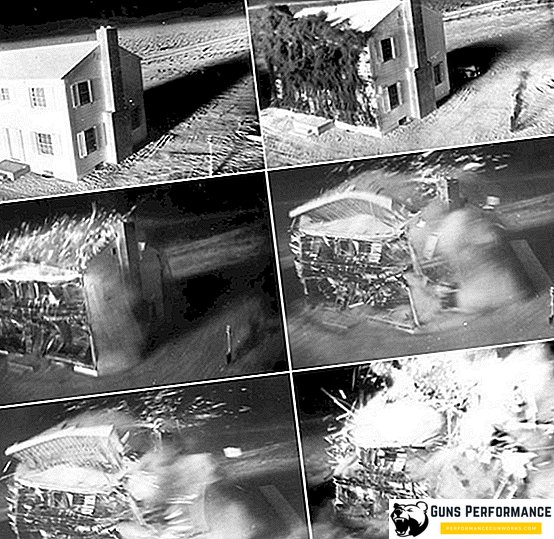
This damaging factor has a direct effect due to excessive pressure and speed, as well as a person can suffer from various debris that it carries. Closer to the epicenter of the wave causes serious seismic vibrations that can bring down underground facilities and communications.
It should be understood that neither buildings nor even special shelters will be able to protect against a shock wave in the immediate vicinity of the epicenter. However, they are quite effective at a considerable distance from it. The destructive power of this factor significantly reduces the folds of the terrain.
Penetrating radiation. This damaging factor is a stream of hard radiation, which consists of neutrons and gamma rays emitted from the epicenter of the explosion. Its effect, like that of light, is of short duration, because it is strongly absorbed by the atmosphere. Penetrating radiation is dangerous for 10-15 seconds after a nuclear explosion. For the same reason, it can affect a person only at a relatively short distance from the epicenter - 2-3 km. When removed from it, the level of radiation exposure decreases rapidly.
Passing through the tissues of our body, the flow of particles ionizes the molecules, disrupting the normal flow of biological processes, which leads to the failure of the most important systems of the body. In severe lesions, radiation sickness occurs. This factor has a devastating effect on some materials, and also disrupts electronic and optical devices.
To protect against penetrating radiation, absorbing materials are used. For gamma radiation, these are heavy elements with a significant atomic mass: for example, lead or iron. However, these substances poorly capture neutrons, moreover, these particles cause induced radioactivity in metals. Neutrons, in turn, are well absorbed by light elements such as lithium or hydrogen. For complex protection of objects or military equipment, multilayered materials are used. For example, the head of a mine installations MBR screened with reinforced concrete and tanks with lithium. When building anti-nuclear shelters, boron is often added to building materials.
Electromagnetic pulse. A striking factor that does not affect human or animal health, but disabling electronic devices.
A powerful electromagnetic field occurs after a nuclear explosion as a result of exposure to hard atoms on the environment. Its effect is short (a few milliseconds), but it is also enough to damage equipment and power lines. Strong ionization of air disrupts the normal operation of radio communications and radar stations, so blasting of nuclear weapons is used to blind the missile attack warning system.
An effective way to protect against EMR is shielding of electronic equipment. It has been used in practice for many decades.
Radiation contamination. The source of this damage factor is the products of nuclear reactions, the unused portion of the charge, as well as induced radiation. Infection in a nuclear explosion poses a serious danger to human health, especially since the half-life of many isotopes is very long.
Infection of air, terrain and objects occurs as a result of the deposition of radioactive substances. They are deposited along the way, forming a radioactive trace. Moreover, as the distance from the epicenter decreases, the danger decreases. And, of course, the area of the explosion itself becomes an area of infection. Most of the hazardous substances fall as precipitation during 12-24 hours after the explosion.
Основными параметрами этого фактора является доза облучения и его мощность.
Радиоактивные продукты способны испускать три вида частиц: альфа, бета и гамма. Первые два не обладают серьезной проникающей способностью, поэтому представляют меньшую угрозу. Наибольшую опасность представляет возможное попадание радиоактивных веществ внутрь организма вместе с воздухом, пищей и водой.
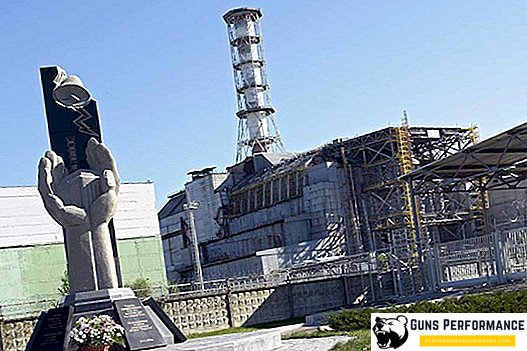
Лучший способ защиты от радиоактивных продуктов - это полная изоляция людей от их воздействия. После применения ЯО должна быть создана карта местности с указанием наиболее загрязненных областей, посещение которых строго запрещено. Необходимо создать условия, препятствующие попаданию нежелательных веществ в воду или пищу. Люди и техника, посещающая загрязненные участки, обязательно должны проходить дезактивационные процедуры. Еще одним эффективным способом являются индивидуальные средства защиты: противогазы, респираторы, костюмы ОЗК.
Правдой является то, что различные способы защиты от ядерного взрыва могут спасти жизнь только, если вы находитесь достаточно далеко от его эпицентра. В непосредственной близости от него все будет превращено в мелкий оплавленный щебень, а любые убежища уничтожены сейсмическими колебаниями.
Кроме того, ядерная атака непременно приведет к разрушению инфраструктуры, панике, развитию инфекционных заболеваний. Подобные явления можно назвать вторичным поражающим фактором ЯО. К еще более тяжелым результатам способен привести ядерный взрыв на атомной электростанции. В этом случае в окружающую среду будут выброшены тонны радиоактивных изотопов, часть из которых имеет длительный период полураспада.
Как показал трагический опыт Хиросимы и Нагасаки, ядерный взрыв не только убивает людей и калечит их тела, но и наносит жертвам сильнейшие психологические травмы. Апокалиптические зрелища постядерного ландшафта, масштабные пожары и разрушения, обилие тел и стоны обугленных умирающих вызывают у человека ни с чем не сравнимые душевные страдания. Многие из переживших кошмар ядерных бомбардировок в будущем так и не смогли избавиться от серьезных разладов психики. В Японии для этой категории придумали специальное название - "Хибакуся".
Атом в мирных целях
Энергия цепной ядерной реакции - это самая мощная сила, доступная сегодня человеку. Неудивительно, что ее попытались приспособить для выполнения мирных задач. Особенно много подобных проектов разрабатывалось в СССР. Из 135 взрывов, проведенных в Советском Союзе с 1965 по 1988 год, 124 относились к "мирным", а остальные были выполнены в интересах военных.
С помощью подземных ядерных взрывов планировали сооружать водохранилища, а также емкости для сберегания природного газа и токсичных отходов. Водоемы, созданные подобным способом, должны были иметь значительную глубину и сравнительно небольшую площадь зеркала, что считалось важным преимуществом.
Их хотели использовать для поворота сибирских рек на юг страны, с их помощью собирались рыть каналы. Правда, для подобных проектов думали пустить в дело небольшие по мощности "чистые" заряды, создать которые так и не получилось.
В СССР разрабатывались десятки проектов подземных ядерных взрывов для добычи полезных ископаемых. Их намеревались использовать для повышения отдачи нефтеносных месторождений. Таким же образом хотели перекрывать аварийные скважины. В Донбассе провели подземный взрыв для удаления метана из угленосных слоев.
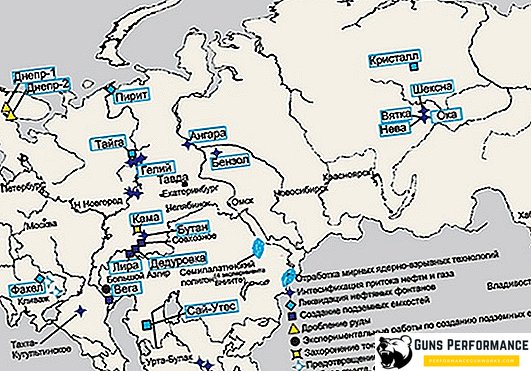
Ядерные взрывы послужили и на благо теоретической науки. С их помощью изучалось строение Земли, различные сейсмические процессы, происходящие в ее недрах. Были предложения путем подрыва ЯО бороться с землетрясениями.
Мощь, скрытая в атоме, привлекала не только советских ученых. В США разрабатывался проект космического корабля, тягу которого должна была создавать энергия атома: до реализации дело не дошло.
До сих пор значение советских экспериментов в этой области не оценено по достоинству. Информация о ядерных взрывах в СССР по большей части закрыта, о некоторых подобных проектах мы почти ничего не знаем. Сложно определить их научное значение, а также возможную опасность для окружающей среды.
В последние годы с помощью ЯО планируют бороться с космической угрозой - возможным ударом астероида или кометы.
Ядерное оружие - это самое страшное изобретение человечества, а его взрыв - наиболее "инфернальное" средство уничтожения из всех существующих на земле. Создав его, человечество приблизилось к черте, за которой может быть конец нашей цивилизации. И пускай сегодня нет напряженности Холодной войны, но угроза от этого не стала меньшей.
В наши дни самая большая опасность - это дальнейшее бесконтрольное распространение ядерного оружия. Чем больше государств будут им обладать, тем выше вероятность, что кто-то не выдержит и нажмет пресловутую "красную кнопку". Тем более, что сегодня заполучить бомбу пытаются наиболее агрессивные и маргинальные режимы на планете.



